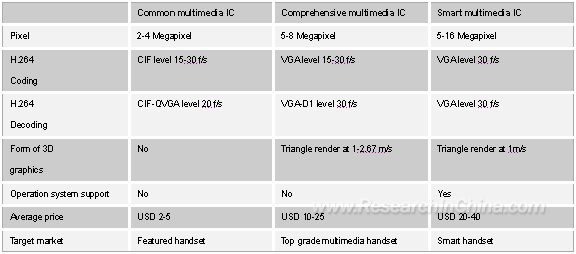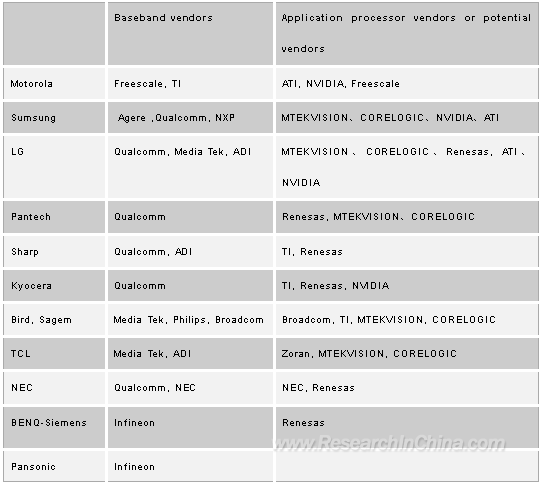| |
|
 |
The wide application of mobile handset multimedia spurs mobile handset multimedia chip. The development course of handset multimedia chip is to some extent the development course of mobile handset functions. Handset multimedia chip, together with other types of applications, are called application processor among industrial practitioners. As for whether the application processor should be combined into the baseband processor, there is no much argument considering both of them has its own market.
For those who have established proper R & D of mobile handset software and hardware, independent exterior application processor is the certain choice in case to retain technologies and acknowledges accumulated in original handset design. Mobile handset design houses made a great effort on the 2G platform and gained a bettered technical system. Such system contains a number of supporting softwares, also passed a series of tests and authentications. Design houses won't give up the intellectual properties accumulated through years of practice. Therefore baseband processors will continue to be used. The multimedia performance can be making up by application processors. Japanese manufacturers and MOTO all have the ability to develop the overall platform to make full use of their accumulation by adopting application processors. Japanese mobile handsets however, adopt application processors much more than the others. TI launched OMAP2420 in Feb, 2004. Soon after that in Aug, 2005, some Japanese manufacturers launched four types of mobile handset, which also adopted OMAP2420. Until now, over 35 types Japan-made mobile handset adopted SH-MOBILE application processor and 20 types adopted OMAP 1610. MOTO, as well had 40 types mobile handsets adopted application processors.
For those who are accustomed to incomplete development platform of software and hardware, single function integrated baseband processor is the best choice. These manufacturer usually depend on overall solutions from big chip vendors when design mobile handsets since they have little of their own. Function integrated baseband processor helps to approach the market rapidly with fairly low cost. But it lacks flexibility in reacting to the market, leading to severe phenomena of same product quality and poor product performance.
Multimedia chip can now be divided into three categories: the core function of the first category is video process, taking H.264 CODEC chip for example, it is used to record and play the video; the core function of the second category is active images process, which are mainly cartoons and games. Display card manufacturers are particularly sophisticated in this kind of process, especially 3D pictures.
However, the core function of the third category is to deal with still images. When camera phone just emerged in the market, exterior application processor was quite common to deal with the still images. As it is easier to process the statistic images, this function was latter integrated into the baseband or into the video processor. With the increasing of camera phone pixel, exterior application processor still has its place. In addition there are also some auxiliary chips, but they are not real multimedia chips, for instance the receiving chip of mobile TV.

Mobile Handset multimedia chip companies fall into the following five categories:

Mobile handset multimedia IC usually has some major functions, including camera pixel processing, H.264 CODEC, video CODEC and chord; some may support the forming of 3D graphics and the operation systems like Linux and Symbian. According to the disparities in performance and functions of multimedia, we can hereby classify handset multimedia IC into three groups, i.e. common multimedia IC, comprehensive multimedia IC and smart Multimedia IC.

On the target companies: Nokia has been cooperating with TI for a long period to develop OMAP application processor. Even ST, Nokia's intimate partner, seldom has a chance to work with Nokia, thus more difficulty for other vendors.
Sony Ericsson relies on TI for customized baseband; Application processors are frequently adopted by Motorola, Sumsung, LG, Pantech, Sharp, Toshiba, Fujitsu, Kyocera, Bird, TCL, Sagem, NEC and BenQ-Siemens.

|
|
|
|
|
If this report could not still meet your requirement, or
you have any comments or suggestions on it, please leave a
message to us.
|
2005-2008 www.researchinchina.com All Rights Reserved
| |
|
 |
| |
|
The wide application of mobile handset multimedia spurs mobile handset multimedia chip. The development course of handset multimedia chip is to some extent the development course of mobile handset functions. Handset multimedia chip, together with other types of applications, are called application processor among industrial practitioners. As for whether the application processor should be combined into the baseband processor, there is no much argument considering both of them has its own market.
For those who have established proper R & D of mobile handset software and hardware, independent exterior application processor is the certain choice in case to retain technologies and acknowledges accumulated in original handset design. Mobile handset design houses made a great effort on the 2G platform and gained a bettered technical system. Such system contains a number of supporting softwares, also passed a series of tests and authentications. Design houses won't give up the intellectual properties accumulated through years of practice. Therefore baseband processors will continue to be used. The multimedia performance can be making up by application processors. Japanese manufacturers and MOTO all have the ability to develop the overall platform to make full use of their accumulation by adopting application processors. Japanese mobile handsets however, adopt application processors much more than the others. TI launched OMAP2420 in Feb, 2004. Soon after that in Aug, 2005, some Japanese manufacturers launched four types of mobile handset, which also adopted OMAP2420. Until now, over 35 types Japan-made mobile handset adopted SH-MOBILE application processor and 20 types adopted OMAP 1610. MOTO, as well had 40 types mobile handsets adopted application processors.
For those who are accustomed to incomplete development platform of software and hardware, single function integrated baseband processor is the best choice. These manufacturer usually depend on overall solutions from big chip vendors when design mobile handsets since they have little of their own. Function integrated baseband processor helps to approach the market rapidly with fairly low cost. But it lacks flexibility in reacting to the market, leading to severe phenomena of same product quality and poor product performance.
Multimedia chip can now be divided into three categories: the core function of the first category is video process, taking H.264 CODEC chip for example, it is used to record and play the video; the core function of the second category is active images process, which are mainly cartoons and games. Display card manufacturers are particularly sophisticated in this kind of process, especially 3D pictures.
However, the core function of the third category is to deal with still images. When camera phone just emerged in the market, exterior application processor was quite common to deal with the still images. As it is easier to process the statistic images, this function was latter integrated into the baseband or into the video processor. With the increasing of camera phone pixel, exterior application processor still has its place. In addition there are also some auxiliary chips, but they are not real multimedia chips, for instance the receiving chip of mobile TV.

Mobile Handset multimedia chip companies fall into the following five categories:

Mobile handset multimedia IC usually has some major functions, including camera pixel processing, H.264 CODEC, video CODEC and chord; some may support the forming of 3D graphics and the operation systems like Linux and Symbian. According to the disparities in performance and functions of multimedia, we can hereby classify handset multimedia IC into three groups, i.e. common multimedia IC, comprehensive multimedia IC and smart Multimedia IC.

On the target companies: Nokia has been cooperating with TI for a long period to develop OMAP application processor. Even ST, Nokia's intimate partner, seldom has a chance to work with Nokia, thus more difficulty for other vendors.
Sony Ericsson relies on TI for customized baseband; Application processors are frequently adopted by Motorola, Sumsung, LG, Pantech, Sharp, Toshiba, Fujitsu, Kyocera, Bird, TCL, Sagem, NEC and BenQ-Siemens.

|
|
|
|
|
2005-2006 www.researchinchina.com All Rights Reserved |
|
| |
|
 |
| |
|
1.Brief Introduction to mobile handset multimedia IC
1.1 Scope and definition in this report
1.2 On H.264 standard
1.2.1 H.264 coding and decoding module structure
1.2.2 H.264 authentication fee
1.3 General situation of mobile handset games platform
1.3.1 J2ME
1.3.2 BREW
1.4 Mobile Handset games platform market
1.5 3D images
1.5.1 Brief introduction to OPEN GL ES
1.6 Major developer of OPENGL ES software and hardware
1.6.1 Falanx
1.6.2 Imagination Technologies
1.6.3 Misubishi Electric Automation
1.6.4 Nvidia
1.6.5 Toshiba
1.6.6 Sony
1.6.7 Bitsboys
1.7 Development trend of application processor and baseband2. Brief introduction to global mobile handset multimedia IC industry and market
2.1 Global mobile handset multimedia IC market
2.2 Market share distribution of major vendors
2.3 Classifications of vendors
2.4 Product and market positioning 3. Mobile Handset multimedia IC vendors
3.1 TI
3.2 ST
3.3 Renesas
3.4 Broadcom
3.5 Neomagic
3.6 ATI
3.7 Nvidia
3.8 Nec
3.9 Toshiba
3.10 Emblaze Semiconductor
3.11 Mtekvision
3.12 CoreLogic
3.13 Freescale
3.14 Sigma Designs
3.15 Sumsung
3.16 Huapont
3.17 Hantro
3.18 Sci-worx
3.19 Faraday
3.20 Marvell
3.21 Jade
3.22 Chipnuts
3.23 Anyka
3.24 Vimicro
|
|
|
|
|
2005-2008 www.researchinchina.com All Rights Reserved |
|
| |
|
 |
| |
|
Framework of H. 264 CODEC with data flow and functional module
Comparison of decoding module between MPEG-2 and H. 264
Internal framework of H. 264 CODEC
Structure of J2ME platform
API at MSA level of CLDC
Cognition of handset game developers towards game platform
Statistics of mobile handset games by platforms
Global shipment of J2ME mobile handset, Q1 2003-Q2 2006
Position taken by Open GL ES in handset software
Module of Graphics Library
Development trends of WCDMA baseband processor
Typical application of OMAPV2230
Global shipment and forecast of multimedia IC mobile handsets, 2004-2009
Global market scale and forecast of mobile handset multimedia IC, 2004-2009
Global Market shares distribution of major handset multimedia IC vendors in 2005 (by shipment)
Global Market shares distribution of major handset multimedia IC vendors in 2006 (by shipment)
Global Market shares distribution of major handset multimedia IC vendors in 2005 (by sales value)
Global Market shares distribution of major handset multimedia IC vendors in 2006 (by sales value)
Handset chip clients of TI
Internal framework of OMAP2420
Internal framework of OMAP3430
Typical application of OMAP3430
Revenue structure of ST in 2005
Revenue of ST in great China Q1 2004-Q1 2006
Top ten distributors of ST in 2005
Target markets for handset application processor of ST
NOMADIK product roadmap of ST
Internal framework of STN 8815
Characteristics of STN 8815
Typical application of STN 8815
Shipment of SH-Mobile processor, 2002-2005
Internal framework of SH-Mobile 3A (SH73380)
Roadmap of SH-Mobile Camera engine
Revenue and gross profit margin of ATI, 2003-2005
Shipment of ATI handset chip, Q1 2005-Q3 2006
Quarterly Gross profit margin of NVIDIA Q3 2004-Q4 2005
Internal framework of MP211
Roadmap of Toshiba application processor
Regional Income structure of Zoran, Q1 2005-Q1 2006
|
2005-2008 www.researchinchina.com All Rights Reserved
|



